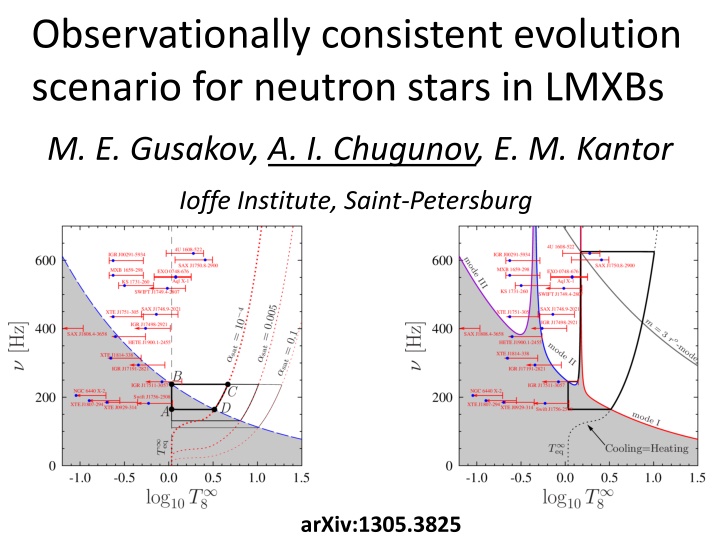
Neutron Star Evolution Scenarios in LMXBs: R-Mode Instability and Superfluid Modes
Explore observationally consistent evolution scenarios for neutron stars in Low-Mass X-ray Binaries (LMXBs), addressing r-mode instability, avoided crossings of normal and superfluid modes, resonance damping, and new instability windows. Understand the complexity of neutron star evolution through various mode regimes and temperature-dependent behaviors.
Download Presentation

Please find below an Image/Link to download the presentation.
The content on the website is provided AS IS for your information and personal use only. It may not be sold, licensed, or shared on other websites without obtaining consent from the author. If you encounter any issues during the download, it is possible that the publisher has removed the file from their server.
You are allowed to download the files provided on this website for personal or commercial use, subject to the condition that they are used lawfully. All files are the property of their respective owners.
The content on the website is provided AS IS for your information and personal use only. It may not be sold, licensed, or shared on other websites without obtaining consent from the author.
E N D
Presentation Transcript
Observationally consistent evolution scenario for neutron stars in LMXBs M. E. Gusakov, A. I. Chugunov, E. M. Kantor Ioffe Institute, Saint-Petersburg arXiv:1305.3825
Neutron stars in LMXBs and r-mode instability Problem: Many neutron stars (NSs) fall well outside the stability region. This fact contradicts existing evolution scenarios. Andersson Transient Gravitational-Wave Sky, arXiv:1305.0816: Very recent Andersson, & Haskell, PRL, 107 (2011),101101], predicted r-mode window to observed accreting systems, suggests understanding complete. The generally accepted r-mode model would lead to a large number of observed systems in fact being unstable. This is an obvious problem that needs to be addressed by models. It is, however, not clear what the missing piece of the puzzle may be. et al., The work [Ho, comparing the instability that far our from is improving our
Normal and superfluid modes: avoided crossings (See poster B3 by Gusakov et al. for details) Two types of modes exist in superfluid NSs: normal and superfluid. Eigenfrequencies of superfluid modes are temperature dependent. In an approximation of completely decoupled modes, the frequencies of superfluid and normal modes can intersect at some temperatures. In reality, the mode coupling leads to avoided crossings of frequencies. As temperature varies, superfluid mode turns into the normal mode and vice versa.
Normal and superfluid modes: resonance damping Resonance damping of normal modes in the vicinity of avoided crossings with superfluid modes is confirmed by direct calculations for nonrotating NSs Kantor&Gusakov (2011); Gusakov et al. (2013) Similar results were obtained for zero- temperature r-modes of rotating superfluid NSs Lee & Yoshida (2003) Yoshida & Lee (2003) Gusakov et al., MNRAS 428 (2013), 1518
New instability windows (See poster B3 by Gusakov et al. for details) Avoided crossings of normal and superfluid modes take place at specific temperatures. As temperature varies, the normal mode turns into superfluid one and vice versa. Main assumption: A stability peak appears, which is limited by m=3 r-mode instability Consequence:
Many mode regime of NS evolution [generalization of one mode evolution by Owen et al. (1998); Ho & Lai (2000)] Amplitude of mode i: Spin frequency: Spin down due to mode dissipation Spin up due to accretion Thermal balance: Heating owing to dissipation of each of the excited modes: Saturation:
Evolution of NSs in LMXBs: climbing up the stability peak Absent in the standard scenario
Evolution of NSs in LMXBs: climbing up the stability peak Absent in the standard scenario
Evolution of NSs in LMXBs: climbing up the stability peak Absent in the standard scenario High temperature is supported by damping of the mode II NS is attached to the stability peak by the mode II instability NS spins up, if
Low temperature NSs: low temperature avoided crossing A number of avoided crossings can take place Climbing up the low temperature stability peak
High temperature avoided crossings High temperature avoided crossings are also possible They do not affect the scenario significantly A strong heating is required at the stage X2X3to maintain high temperature Spin down through mode I dissipation dominates The scenario is very stable with regard to variation of model parameters
Results and Conclusions Resonance coupling of normal and superfluid modes plays the key role in the evolution of NSs in LMXBs It allows us to explain the existence of rapidly rotating warm NSs and cutoff of their spin frequency distribution at >730 Hz [D. Chakrabarty et al., Nature 424 (2003), 42] A phenomenological model of resonance coupling is developed and justified Avoided crossings lead to enhanced damping and formation of the stability peak, limited by m=3 r-mode instability NSs spend significant amount of time climbing up the stability peak Temperatures of rapidly rotating NSs in our model are fixed to the resonance temperatures The scenario can be applied to millisecond pulsars See arXiv:1305.3825 for details
